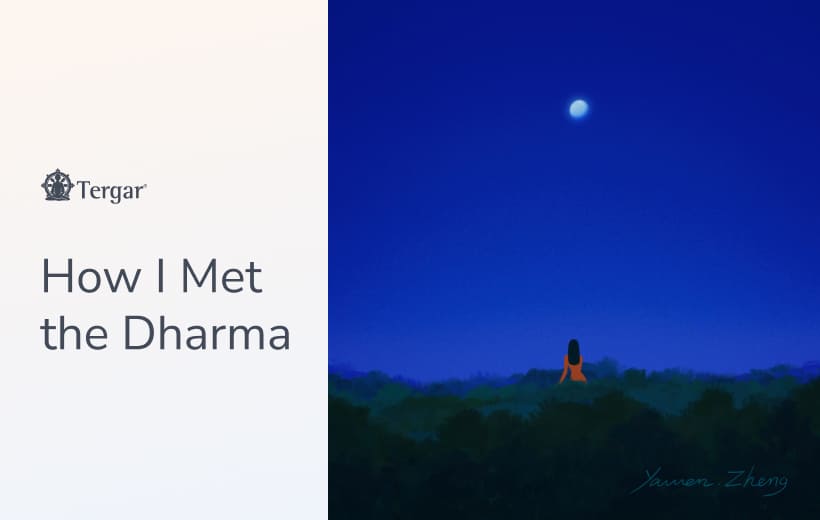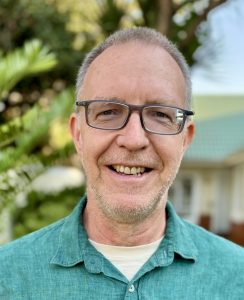The Quiet Power of Returning—Again and Again—to the Path
By Alex Welte • 3 min read
By Alex Welte • 3 min read

WHEN I WAS STILL ACTIVELY SMOKING, years ago, I would boast of having quit several times just in the last day. When intermittent fasting became popular and popped up in conversations, I would usually declare that I was fully committed to it, having fasted at least a dozen times in the last twenty-four hours. With dharma, it’s a bit like that. When prodded to reflect on ‘how I met the dharma’, I can’t help but wonder: which time? It feels like I keep meeting the dharma again and again and again around the next corner – and each time it is both like a breath of fresh air, and like coming home.
Looking back at the long-before-the-internet days of my childhood, first in Germany and then in South Africa, it impresses me that even in my devout Catholic home, and the much more inward looking mainly Protestant milieu of my school, I long ago acquired some awareness of Buddhism, meditation, and a notion of spiritual ‘awakening’. Some really tiny, incidental references to these topics, though barely understood at the time, somehow stuck with me. These seeds, planted sparsely here and there, took a long time to sprout.
And so it was, that having been confirmed in the Catholic Church at a younger-than-usual age, and then baptised in a South African variant of the US Baptist or Pentecostal church, I arrived at the University of the Witwatersrand, in Johannesburg, in 1987, in the heat of South Africa’s battle for freedom from apartheid, ready to jump into things: Physics, mathematics, revolution, literature, enlightenment; not to mention new-age self-development, psychotherapy, sex, drugs, and rock and roll.
Now, whether it is most accurately labelled laziness, generalised anxiety, ADD (with or without the H), or just a perpetual, gnawing, longing for reliable refuge from the hollowness of samsara, I can’t really say – but I know that even though I loved what I was studying, and was considered good at it, assignments were a torment, and exams were a greater torment. I started to meditate in second year, just counting the breaths according to my understanding of the guidance of Roshi Philip Kapleau. Grades remained good. The struggle became more serious in my third year, but my fumbling meditation practice somehow saw me through an ongoing crisis of confidence and the struggle to maintain attention.
Some steps forward, some steps back. Some steps forward, some steps back. So it went with my meditation practice. So it went with my relationships. So it went with my career. Life remained manageable, even rich, but I felt always on the edge of the next crisis, haunted by the fear that I would eventually be left just somehow barely surviving, never really fulfilling my youthful yearning for that epic journey through physics, mathematics, revolution, literature, and enlightenment.
“It feels like I keep meeting the dharma again and again and again around the next corner — and each time it is both like a breath of fresh air, and like coming home.”
– Alex Welte
Wonderful yoga teachers entered and left my life. Exciting work, with wonderful learnings, came and went. One family broke up, another formed. Then came a new encounter with the dharma, through the sangha linked to Samye Ling, and it dug in deeply. I had never before felt drawn to what I viewed as culturally-specific ‘practices’ or ‘rituals’ – but somehow I was drawn to the glimpses I got of foundational practices (Ngöndro); creation stage practices like constructing intricate visualisations of, and relationships with, ‘Deities’; and some unclear talk of encounters with teachers who might ‘point’ to something.
In 2008, I encountered a flyer advertising a tentatively planned, but in the end cancelled, visit by a dynamic young lama, who would offer the deepest teachings accessible outside the setting of a long retreat. The grey-toned snapshot of this lama was so brimming with energy that I felt invigorated by the memory of it for days afterwards, but the flash faded, and I didn’t clearly recall the face even when I saw it again two years later on the cover of a book handed to me by a friend. ‘The Joy of Living’ it was called. I couldn’t sit still and read it, but felt I had to make a connection, and then found Tergar International just developing its online presence.
How to practice? How to make it more integral to my daily life in work and relationships? It’s an ongoing journey, not a single course correction. Various teachers of dharma, notably from the Vajrayana tradition, and most especially Mingyur Rinpoche, have given me a lot of help. I recently figured out which friend from Cape Town had made that flyer I found in Johannesburg in 2008, and now he is working, with others, to prepare for Mingyur Rinpoche’s actual first visit to South Africa (or any part of Africa) in August/September 2025.
I have no idea where I will ‘get to’ on my journey. I do know that with a bit of steady practice of meditation, learning about the amazing – but – normal, human qualities within me, that are also within everyone else, within our mind, this precious human life is, and will remain, a good journey; and even though I often, especially lately, view the world with horror, I do treasure my brushes with physics, mathematics, revolution, literature, and enlightenment.

Alex Welte is a physicist by training and a wrangler of data for biomedical and public health research by trade – and a teacher of mathematics and basic science at heart. He lives in Durban, and is a practice facilitator for Tergar South Africa.
Learn meditation under the skillful guidance of world-renowned teacher Yongey Mingyur Rinpoche at your own pace.


“Rinpoche has so beautifully given the essence in such a simple and accessible manner that other masters would hesitate to give until the student has spent maybe twenty years with them.” – Arun Poudel

In this moving account, Alex Kunkhyen reveals how the suffering of addiction became the unexpected path to freedom through the Dharma.

Like riding a bike without training wheels for the first time, a simple teaching from Mingyur Rinpoche unlocked a path of freedom, carrying one meditator across continents, through crisis, and into the heart of awareness—where teaching others became the greatest joy of all.
If you enjoyed reading our articles, please join our mailing list and we’ll send you our news and latest pieces.